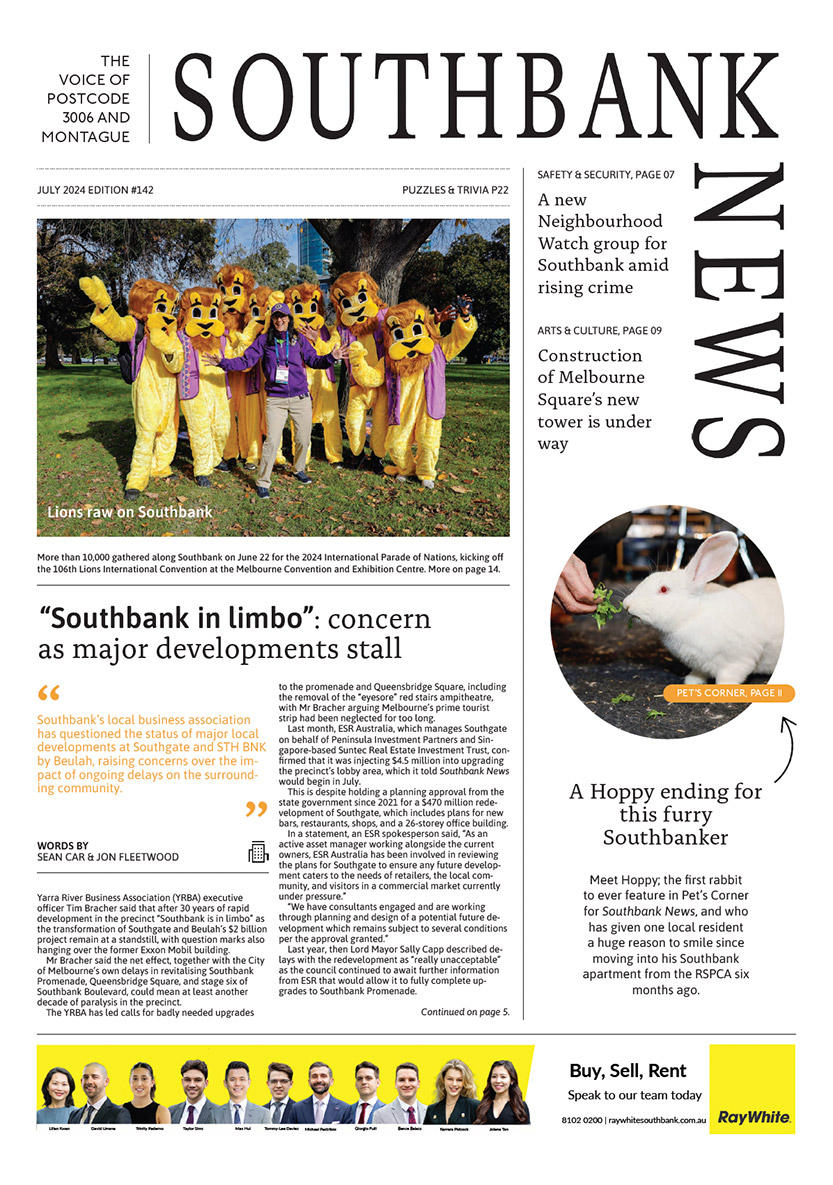Oops! Council admits contractor blunder over steel walkway
The City of Melbourne has been left red-faced after admitting contractors used steel rather than timber for a new walkway as part of the problem-plagued Southbank Boulevard project.
The blunder comes after the steel grating walkway was slammed by residents as “dangerous” and a “rubbish trap” with the grates also causing a dog’s paws to get stuck.
The walkway is part of a new neighbourhood park between Fawkner St and City Rd, which opened to the public last November.
The council’s error is the latest bungle in the Southbank Boulevard project, which has already been beset by delays and disruptions, with the works becoming the council’s most expensive in history with costs blowing out from an estimated $34 million to $47 million since works began in 2017.
A City of Melbourne spokesperson apologised for the walkway mix-up, saying it would be fixed “as soon as possible”.
“Unfortunately, the contractor installed the incorrect steel grating material along the walkway,” the spokesperson said.
“Council has requested the material be replaced as soon as possible with closely spaced decking – as originally planned.”
We apologise to the community for this error and look forward to seeing locals enjoy these much-needed open new spaces.
Southbank Residents Association president Tony Penna said he was surprised when he saw the steel walkway after the park opened and immediately raised it with the council late last year.
“I referred them to the renders, and I said the plan was always a boardwalk not a metal-walk,” he said.
Many residents and visitors to Southbank Boulevard took to social media to vent their fury about the new steel walkway.
“It’s so awful! Already so much rubbish under it too,” one wrote.
“How are prams meant to wheel over this smoothly? Honestly, Southbank keeps the child-unfriendly designs flowing,” another said.
The council said the replacement decking would be consistent with the “high-quality presentation and amenity” that council intends for this new civic space.
Aline Silvestre, who recently moved out of Southbank, believed the walkway was “dangerous” for children and pets after her dog’s paws got caught in the grates.
“My dog didn’t get to the point of hurting her paw thankfully, because I took her out quickly. But as soon as we got to the platform, I could feel how uncomfortable she was,” she said.
“I understand it looks beautiful and it’s nice to bring some ‘nature feelings’ to the city, but it’s not practical.”
Southbank resident and community advocate Jannine Pattison said the mistake from the contractor had added to the “debacle” since the Southbank Boulevard project had begun.
“While the upgrades of Southbank Boulevard are an improvement on what was originally there, it was such a lost opportunity, and the council can take a lot of learnings from this project into its future planning for Southbank and Melbourne.”
Meanwhile, the final piece of the Southbank Boulevard project is under way, with a $2.4 million new play space being built between Kavanagh and Fawkner streets – with works to be completed in September.
The 1000-square-metre space will feature climbing boulders, swings, slides, and ladders as well as new trees and street furniture. Existing on-site infrastructure will be demolished in early February before construction begins.
Lord Mayor Sally Capp said it would be one the largest new spaces being delivered as part of the Southbank Boulevard transformation.
“It’s important in times like these to keep delivering key projects, and I’m pleased to say the final piece of the Southbank Boulevard transformation is officially underway,” she said.
“We know it’ll become a much-loved facility for local families in one of our most densely populated suburbs.”
Resident David Hamilton, said while he was pleased works would finish this year, “It’s just been a badly conceived project from the very beginning, and execution of a badly conceived project can’t rescue it”.
A business owner said works from the initial stages of the project had “become so disruptive we had to move”. “I lost hundreds of thousands of dollars in revenue,” the owner, who asked not to be named, said •

A new Neighbourhood Watch group for Southbank







 Download the Latest Edition
Download the Latest Edition